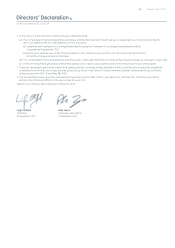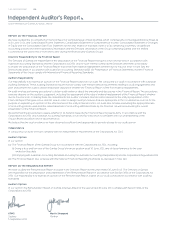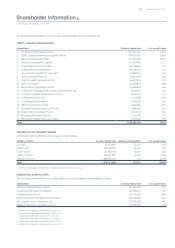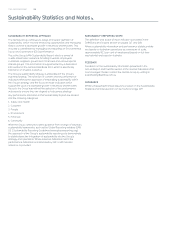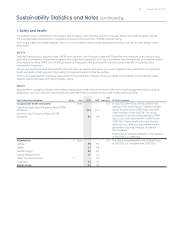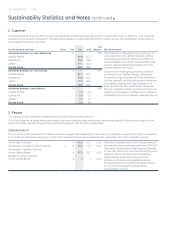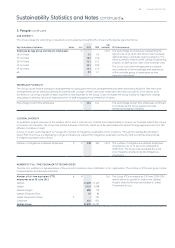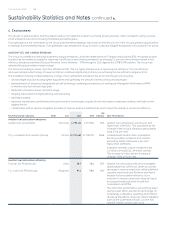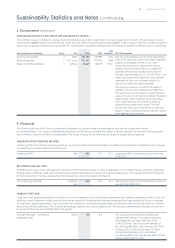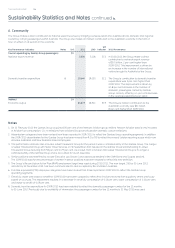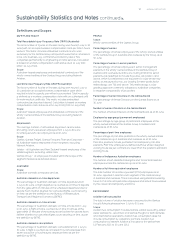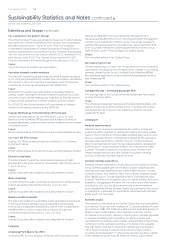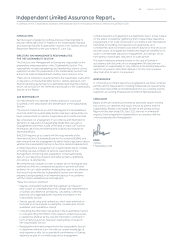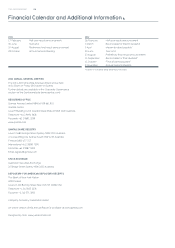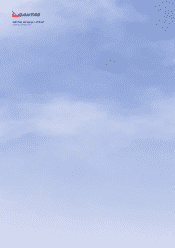Qantas 2011 Annual Report Download - page 119
Download and view the complete annual report
Please find page 119 of the 2011 Qantas annual report below. You can navigate through the pages in the report by either clicking on the pages listed below, or by using the keyword search tool below to find specific information within the annual report.
117 ANNUAL REPORT 2011
Sustainability Statistics and Notes continued
SAFETY AND HEALTH
Total Recordable Injury Frequency Rate (TRIFR) (Australia)
The total number of injuries or illnesses during work hours ( July to
June) with an accepted workers compensation claim per million hours
worked. This metric includes embedded contractors who work
exclusively for the Qantas Group and perform work that is considered
to be core business, e.g. contractors provided by labour hire
companies permanently to engineering or ramp services. Calculation
is based on workers compensation claim status as at July
(: July ).
Scope:
Australian-based employees and embedded contractors of the
wholly-owned entities of the Qantas Group excluding Network
Aviation.
Lost Work Case Frequency Rate (LWCFR) (Australia)
The total number of injuries or illnesses during work hours ( July to
June) with an accepted workers compensation claim which
resulted in total incapacity, per million hours worked. Total incapacity
is dened as a workers compensation claim with an authorised unt
for work medical certicate. This metric includes embedded
contractors (as described above). Calculation is based on workers
compensation claim status as at July (: July ).
Scope:
Australian-based employees and embedded contractors of the
wholly-owned entities of the Qantas Group excluding Network
Aviation.
Absenteeism
The average number of annualised days taken as sick leave
(including carer’s leave) per employee from July to June
for employees who are employed as at June.
Scope:
Qantas, Qantas Freight, Qantas Frequent Flyer and Corporate –
all Australian-based employees of each segment, excluding
Network Aviation.
Jetstar – all Australian and New Zealand-based employees of the
Jetstar segment, excluding Jetstar Asia.
Qantas Group – all employees included within the scope of the
segment measures as detailed above.
CUSTOMER
Scope:
Australian domestic scheduled services.
Australian domestic on-time departures
The percentage of Australian domestic on-time departures from
July to June. A ight departure is counted as on time if it departs
from the gate within minutes of the scheduled departure time for
sectors own. Neither diverted nor cancelled ights count as being
on time, as per the denition by the Bureau of Infrastructure,
Transport and Regional Economics (BITRE).
Australian domestic on-time arrivals
The percentage of Australian domestic on-time arrivals from July
to June. A ight arrival is counted as on time if it arrives at the
gate within minutes of the scheduled arrival time for sectors own.
Neither diverted nor cancelled ights count as being on time, as per
the denition by BITRE.
Australian domestic cancellations
The percentage of Australian domestic cancellations from July to
June. A ight is counted as cancelled if it is cancelled less than
seven days prior to its scheduled departure time, as per the
denition by BITRE.
PEOPLE
Scope:
Wholly-owned entities of the Qantas Group.
Percentage of women
The percentage of female employees of the wholly-owned entities
of the Qantas Group in Australia and overseas by the Group as at
June.
Percentage of women in senior positions
The percentage of female employees in senior management
positions in the wholly-owned entities of the Qantas Group in
Australia and overseas as at June. During / senior
positions was redened to include Executive Job Grade and
above, which is considered to be equivalent to a job whose Hay
points, as measured by Hay Job Grading Scheme points factor
methodology, are and above. This methodology is a job
grading approach commonly adopted by Australian companies
to establish comparability of job proles.
Percentage of women Directors on the Qantas Board
The percentage of female Directors on the Qantas Board as at
June.
Number of women Directors on the Qantas Board
The number of female Directors on the Qantas Board as at June.
Employee by age group (permanent employees)
The percentage by age group of permanent employees of the
wholly-owned entities of the Qantas Group in Australia and
overseas as at June.
Percentage of part-time employees
The percentage of part-time positions in the wholly-owned entities
of the Qantas Group in Australia and overseas as at June.
Part-time positions include permanent and temporary part-time
positions. Part-time employees is dened as those whose assigned
working hours (as per contract) are lower than the position’s standard
working hours.
Number of Indigenous Australian employees
The number of self-identied Aboriginal and Torres Strait Islander
employees across the Qantas Group as at June.
Number of full-time equivalent employees
The total number of full-time equivalent (FTE) employees as at
June, reported in total for each segment of the Qantas Group
in Australia and overseas. This is calculated using standard working
hours for full-time and part-time employees and actual hours worked
by the casual and temporary workforce.
ENVIRONMENT
Aviation fuel consumption
The total volume of aviation kerosene consumed by the Qantas
Group’s ying businesses from July to June.
Scope:
Aviation fuel consumption includes Qantas, Jetstar (excluding Jetstar
Asia), QantasLink, Jetconnect and Qantas Freight, for both domestic
and international operations. Aviation fuel consumption does not
include consumption by codeshare partners. Aviation fuel
consumption by Network Aviation is included for the period from
February to June .
Denitions and Scopes


